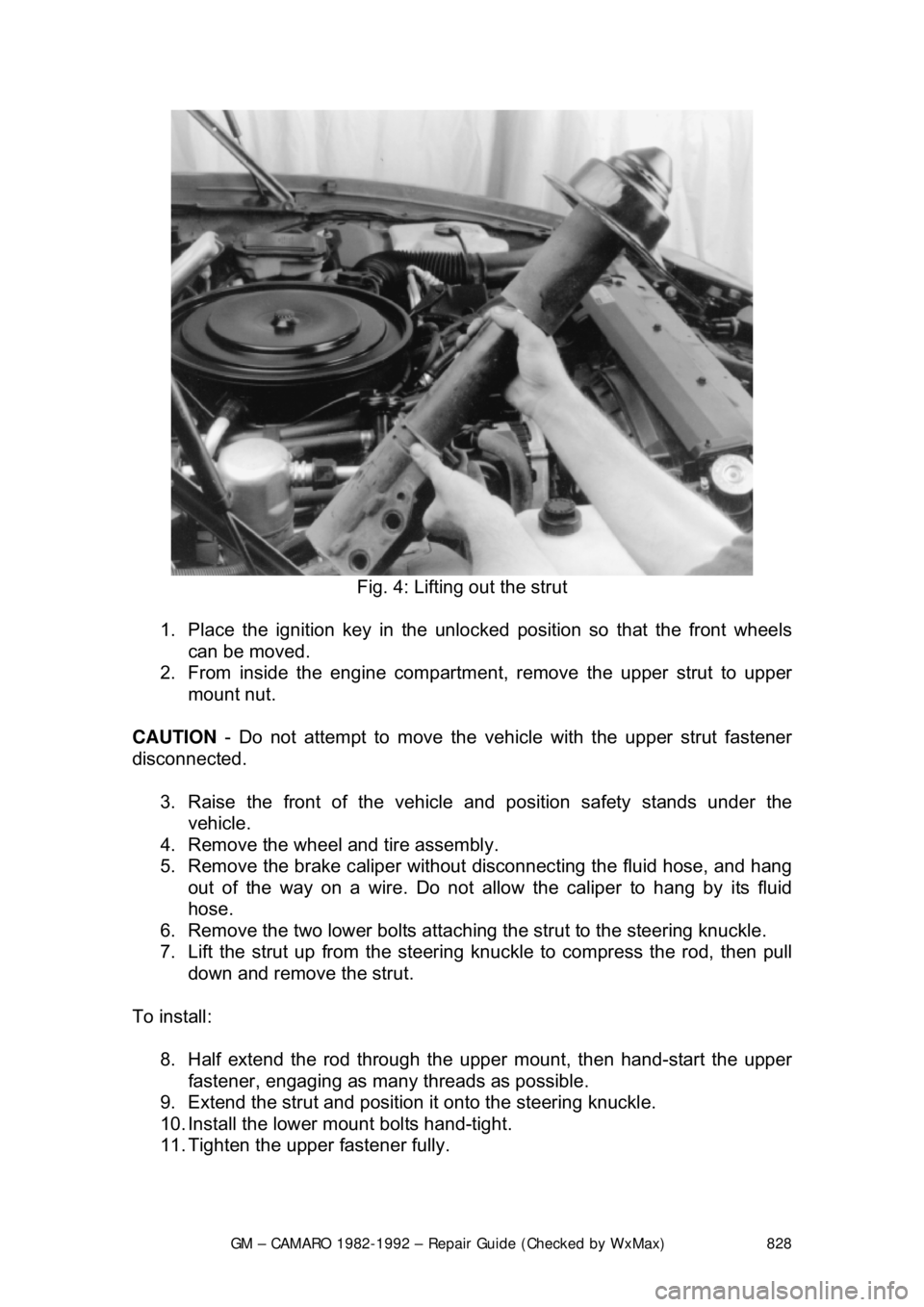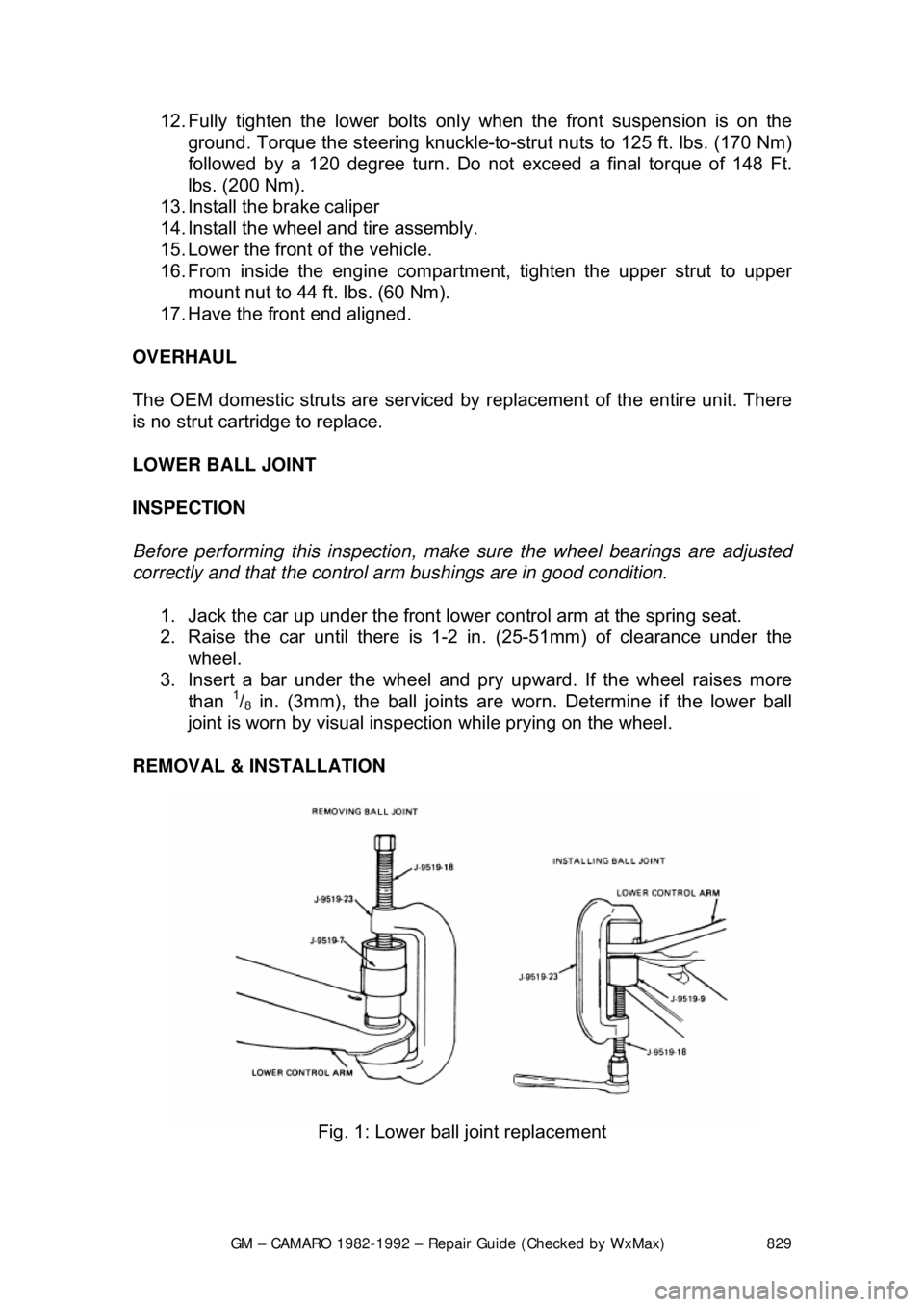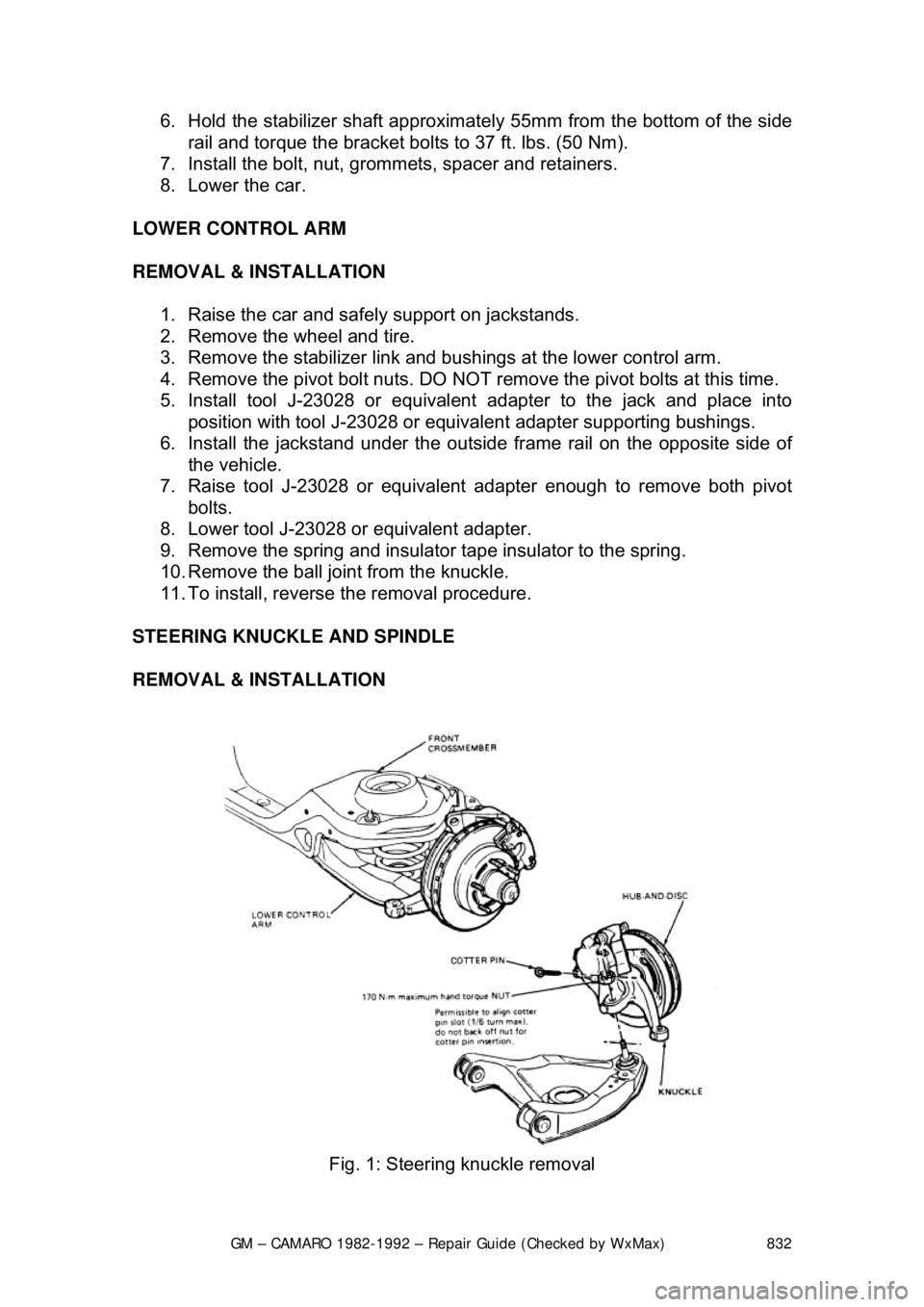Page 825 of 875

GM – CAMARO 1982-1992 – Repair Guide (Checked by WxMax) 825
5. Disconnect the tie rod from the
steering knuckle using a ball joint
remover.
6. Using an internal fit coil spring co mpressor, compress the coil spring so
that it is loose in its seat.
CAUTION - Be sure to follow manufacturer' s instructions when using spring
compressor. Coil springs in a comp ressed state contain enormous energy
which, if released accidentally, could cause serious injury.
7. To remove the coil spring, disc onnect the lower control arm from the
crossmember at the pivot bolts. If additional clearance is necessary,
disconnect the lower control arm from the steering knuckle at the ball
joint.
To install: 8. Compress the coil spring until spri ng height is the same as when
removed, then position the spring on the control arm. Make sure the
lower end of the coil spring is properly positioned in the lower control arm
and that the upper end fits correctly in its pad.
9. Connect the lower control arm from t he steering knuckle at the ball joint.
Connect the lower control arm from t he crossmember at the pivot bolts
and install the coil spring.
10. Connect the tie rod to the steering knuckle.
11. Attach the steering gear unit.
12. Connect the stabilizer link to the lower control arm.
13. Install the wheel(s).
14. Lower the vehicle.
Page 828 of 875

GM – CAMARO 1982-1992 – Repair Guide (Checked by WxMax) 828
Fig. 4: Lifting out the strut
1. Place the ignition key in the unlock ed position so that the front wheels
can be moved.
2. From inside the engine compartm ent, remove the upper strut to upper
mount nut.
CAUTION - Do not attempt to move the ve hicle with the upper strut fastener
disconnected.
3. Raise the front of the vehicl e and position safety stands under the
vehicle.
4. Remove the wheel and tire assembly.
5. Remove the brake caliper without disconnecting the fluid hose, and hang
out of the way on a wire. Do not allo w the caliper to hang by its fluid
hose.
6. Remove the two lower bolts attachi ng the strut to the steering knuckle.
7. Lift the strut up from the steering k nuckle to compress the rod, then pull
down and remove the strut.
To install: 8. Half extend the rod through th e upper mount, then hand-start the upper
fastener, engaging as many threads as possible.
9. Extend the strut and position it onto the steering knuckle.
10. Install the lower mount bolts hand-tight.
11. Tighten the upper fastener fully.
Page 829 of 875

GM – CAMARO 1982-1992 – Repair Guide (Checked by WxMax) 829
12. Fully tighten the lower bolts onl
y when the front suspension is on the
ground. Torque the steering knuckle-to-strut nuts to 125 ft. lbs. (170 Nm)
followed by a 120 degree turn. Do not exceed a final torque of 148 Ft.
lbs. (200 Nm).
13. Install the brake caliper
14. Install the wheel and tire assembly.
15. Lower the front of the vehicle.
16. From inside the engine compartm ent, tighten the upper strut to upper
mount nut to 44 ft. lbs. (60 Nm).
17. Have the front end aligned.
OVERHAUL
The OEM domestic struts are serviced by replacement of the entire unit. There
is no strut cartridge to replace.
LOWER BALL JOINT
INSPECTION
Before performing this inspection, make sure the wheel bearings are adjusted
correctly and that the control arm bushings are in good condition.
1. Jack the car up under the front lower control arm at the spring seat.
2. Raise the car until t here is 1-2 in. (25-51mm) of clearance under the
wheel.
3. Insert a bar under the wheel and pr y upward. If the wheel raises more
than
1/8 in. (3mm), the ball joints are worn. Determine if the lower ball
joint is worn by visual inspec tion while prying on the wheel.
REMOVAL & INSTALLATION
Fig. 1: Lower ball joint replacement
Page 830 of 875
GM – CAMARO 1982-1992 – Repair Guide (Checked by WxMax) 830
To prevent component dam
age, an on-car ball joint press, such as Kent-Moore
tool J-9519-23 should be used.
1. Raise and safely support the vehicle, then remove the wheel.
2. Support the lower control arm spring seat with a jack.
3. Loosen the lower ball stud nut. Break the ball stud loose. Remove the
ball stud nut.
4. Remove the ball stud from the steering knuckle. Support the steering
knuckle aside using a hanger or wire.
5. Using a ball joint press, remove the ball joint from the lower control arm.
To install: 6. Install the new ball joint, using the press.
7. Install the ball stud in the steering knuckle boss.
8. Install the nut on the ball stud, ti ghtening to 77 ft. lbs. (105 Nm) on all
models. Continue to tighten the nut until the cotter pin holes align and
install the pin. Do not back o ff the nut to align the holes.
9. Install the lube fitting and grease the new joint.
Page 832 of 875

GM – CAMARO 1982-1992 – Repair Guide (Checked by WxMax) 832
6. Hold the stabilizer shaft approximat
ely 55mm from the bottom of the side
rail and torque the bracket bolts to 37 ft. lbs. (50 Nm).
7. Install the bolt, nut, grommets, spacer and retainers.
8. Lower the car.
LOWER CONTROL ARM
REMOVAL & INSTALLATION 1. Raise the car and safely support on jackstands.
2. Remove the wheel and tire.
3. Remove the stabilizer link and bush ings at the lower control arm.
4. Remove the pivot bolt nuts. DO NOT re move the pivot bolts at this time.
5. Install tool J-23028 or equivalent adapter to the jack and place into
position with tool J-23028 or equival ent adapter supporting bushings.
6. Install the jackstand under the outsi de frame rail on the opposite side of
the vehicle.
7. Raise tool J-23028 or equivalent adapter enough to remove both pivot
bolts.
8. Lower tool J-23028 or equivalent adapter.
9. Remove the spring and insulato r tape insulator to the spring.
10. Remove the ball joint from the knuckle.
11. To install, reverse the removal procedure.
STEERING KNUCKLE AND SPINDLE
REMOVAL & INSTALLATION
Fig. 1: Steering knuckle removal
Page 833 of 875

GM – CAMARO 1982-1992 – Repair Guide (Checked by WxMax) 833
1. Siphon some brake fluid from the ma
ster cylinder. Raise and support the
vehicle.
2. Remove the wheel and tire. Remo ve the brake hose from the strut.
3. Remove the caliper and support on a wire. Refer to Brakes for
procedures, then remove the hub-and-disc.
4. Remove the splash shield. Disc onnect the tie rod from the steering
knuckle.
5. Support the lower control arm and disconnect the ball joint from the
steering knuckle using tool J-24292A.
6. Remove the 2 bolts securing the stru t to the steering knuckle and remove
the steering knuckle.
To install: 7. Place the steering knu ckle into position and install the 2 bolts securing
the strut to the st eering knuckle.
8. Support the lower control arm and c onnect the ball joint to the steering
knuckle.
9. Connect the tie rod to the steering knuckle. Install the splash shield.
10. Install the caliper.
11. Install the brake hose from the strut. Install the wheel and tire.
12. Lower the vehicle and refill the master cylinder with brake fluid.
FRONT WHEEL BEARINGS
ADJUSTMENT
Fig. 1: Wheel bearing adjustment
Page 834 of 875

GM – CAMARO 1982-1992 – Repair Guide (Checked by WxMax) 834
1. Raise the car and support it at the lower arm.
2. Remove the hub dust cover and spindle cotter pin. Loosen the nut.
3. While spinning the wheel
, snug the nut down to seat the bearings. Do not
exert over 12 ft. lbs. (16 Nm) of force on the nut.
4. Back the nut off
1/4 turn or until it is just loos e. Line up the cotter pin hole
in the spindle with the hole in the nut.
5. Insert a new cotter pin. E ndplay should be between 0.001-0.005 in.
(0.03-0.13mm). If play exceeds this to lerance, the wheel bearings should
be replaced.
REMOVAL & INSTALLATION 1. Raise the car and support it at t he lower arm. Remove the wheel.
Remove the brake caliper and support it on a wire.
2. Remove the dust cap, cotter pin, ca stle nut, thrust washer and outside
wheel bearing. Pull the disc/hub assemb ly from the steering knuckle.
3. Pry out the inner seal and remove the inner bearing. If necessary to
remove the inner bearing races, use a hammer and a brass drift to drive
the bearing races from the hub.
4. Clean all parts in kerosene or e quivalent, DO NOT use gasoline. After
cleaning, check parts for excessive wear and replace damaged parts.
5. Smear grease inside of hub. Install the bearing races into hub, using a
hammer and a brass drift. Drive the ra ces in until they seat against the
shoulder of the hub.
6. Pack the bearings with grease and install the inner bearing in the hub.
Install a new grease seal, be careful not to damage the seal.
7. Install the disc/hub assembly onto t he steering knuckle. Install the outer
bearing, thrust washer and castle nut. Tighten the nut until the wheel
does not turn freely.
8. Back off the nut until the wheel tu rns freely and install the cotter pin.
Install the dust cap, caliper and wheel. Lower the car.
PACKING
Clean the wheel bearings thoroughly with solvent and check their condition
before installation.
CAUTION - Do not blow the beari ng dry with compressed ai r as this could allow
the bearing to turn without lubrication.
Apply a sizable amount of lubricant to the palm of one hand. Using your other
hand, work the bearing into the lubricant so that the grease is pushed through
the rollers and out the other side. Keep ro tating the bearing while continuing to
push the lubricant through it.
Page 835 of 875
GM – CAMARO 1982-1992 – Repair Guide (Checked by WxMax) 835
FRONT END ALIGNMENT
DESCRIPTION
Fig. 1: Alignment characteristics
CAMBER
Camber is the inward or outward tilting of the front wheels from the vertical.
When the wheels tilt outward at the top, the camber is said to be positive (+).
When the wheels tilt inward at the top, the camber is said to be negative (-). The
amount of tilt is measured in degrees from the vertical and this measurement is
called the camber angle.
CASTER
Caster is the tilting of the front steering axis either fo rward or backward from the
vertical. A backward tilt is said to be posit ive (+) and a forward tilt is said to be
negative (-).
TOE
Toe is the turning in of t he front wheels. The actual am ount of toe-in or toe-out
is normally only a fraction of a degree. T he purpose of toe is to ensure parallel
rolling of the front wheels. Excessive t oe-in or toe-out will cause tire wear.